THE BEST BACK WORKOUTS FOR MASS
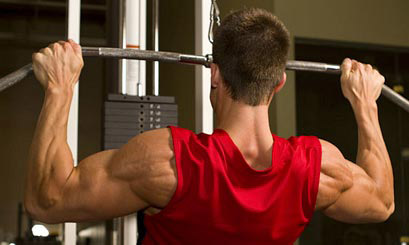
Let’s be honest… for most average lifters in the gym, it’s all about building big pecs, shoulders and arms. Whether it’s done consciously or not, these “showy” muscles tend to be trained with greater focus and intensity than most of the other muscle groups of the body.
The truth is, if your goal is to build a muscular, powerful looking physique, this type of approach is completely backwards.
Although it’s tough to see in the mirror, there is a much larger, more intricate reservoir of muscle nearby that will cause you to appear much wider and thicker when properly developed than a set of decent pecs or biceps will.
I’m talking of course about the muscles of the back. This is where about 70% of your total upper body muscle mass resides, and if you’re neglecting your back training in any way, you’re missing out on some serious gains.
In this article I’ll be discussing how the best back workouts for mass should be structured, along with a concrete training plan at the end that you can follow.
Let’s get started…
Back Muscle Anatomy
To simply lump all the muscles together by referring to it as the “back” isn’t giving nearly enough credit. The back is actually a highly complex set of individual muscle groups that all need to be properly stimulated if you want to see maximum gains.
The major groups to pay attention to for bodybuilding purposes are the lats, traps, rhomboids, teres groups, and spinal erectors.
It might sound complicated, but many of these groups fire simultaneously when you perform the basic back exercises I’ll be outlining below.
Exercise Selection
The best back workouts for mass don’t need to be highly complicated, and you really only need a few basic movements in order to hit all of these muscles sufficiently.
The first is a basic bent-legged deadlift…
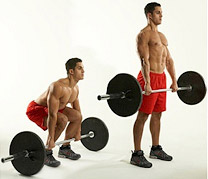
Unless there is a very specific reason why you’re unable to perform them (such as a lower back injury), a bent-legged deadlift should be a core exercise in your back workout.
While the deadlift also hammers the quads, hamstrings, glutes and abs, it also packs mass onto your mid and upper back like no other lift can.
I’d suggest positioning deadlifts as the first exercise in your routine so that they can be performed when your strength and energy is at its highest.
If you find deadlifts particularly taxing to the point that it interferes with the rest of your workout, performing them last is also an option.
The second is a vertical pulling movement…
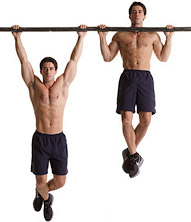
These exercises mainly target the lats for overall back width.
There are a variety of highly effective vertical pulling movements available, and much of it will come down to your own personal preference. After performing your deadlifts, I’d recommend selecting one of the following lifts…
* Wide-grip overhand chin-ups
* Wide-grip overhand lat pulldowns
* Close-grip underhand chin-ups
* Close-grip underhand lat pulldowns
* V-bar pulldowns
I tend to favor the overhand variations as it is easier to preclude the use of the biceps on these exercises in comparison to the closer grip, underhand versions.
Limiting bicep involvement is a major aspect of effective back training, and I would highly recommend checking out my previous post “4 Back Training Tips For Big Lats” for some very useful information on that topic. (The link will open in a new window)
The third is a horizontal pulling movement…
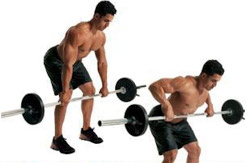
Usually referred to as “rows”, a horizontal pulling movement also hits the lats but places a lot of emphasis on the mid-back muscles as well for overall back thickness.
I’d recommend choosing one of the following lifts for your horizontal pulling movement…
* Bent over barbell rows
* Bent over dumbbell rows
* One-arm dumbbell rows
* T-bar rows
* Seated cable rows
My suggestion is to stick with one of the top 3 free weight choices, with my personal favorite being the one-arm dumbbell row.
If you have lower back issues, go with a horizontal pulling movement that keeps your back supported. This could include a hammer strength machine row, supported t-bar row or incline bench dumbbell row.
On top of this, there is also a second horizontal pull that most lifters would probably be wise to include as well…
That exercise is the “face pull”, which is basically a rope attachment row where the resistance is pulled towards, you guessed it, your face.
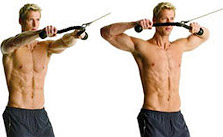
This exercise targets all of the muscles of the upper back along with the rear delts. Most lifters tend to have an imbalance between their upper back/rear delts and their pecs/front delts due to an overemphasis on pressing movements.
Over time, this gradually pulls the shoulder joint forward and out of place, which can then set the stage for shoulder injury.
Face pulls are a great exercise not only for upper back hypertrophy, but also as an injury prevention tool to counteract this potential imbalance.
I won’t call them mandatory, but I can’t see any good reason not to perform a few sets as part of your back routine.
The fourth is a shrugging movement…
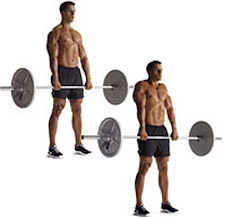
Although the deadlift will stimulate the traps effectively, finishing off your back workout with a few sets of shrugs is a great way to maximize your upper trap growth.
Any basic shrugging exercise will work just fine…
* Barbell shrugs
* Dumbbell shrugs
* Smith machine shrugs
* Cable shrugs
Choose whichever variation you personally prefer.
Best Back Workouts For Mass: Putting It Together
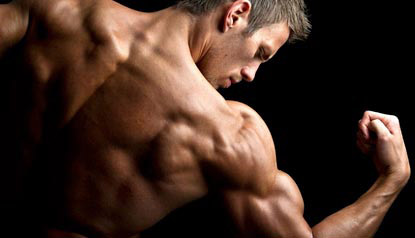
Alright, let’s combine all of this information into a concrete, step-by-step workout plan. Keep in mind that this workout is just one possible option, as you can substitute in any of the “approved” exercises I listed above…
|
Exercise
|
Sets
|
Reps
|
|
Barbell Deadlift
|
2 – 4
|
5 – 7
|
|
Overhand Wide-Grip Chin Up
|
2 – 4
|
5 – 7
|
|
One-Arm Dumbbell Row
|
2 – 4
|
5 – 7
|
|
Face Pulls
|
2 – 4
|
8 – 10
|
|
Dumbbell Shrug
|
2 – 4
|
8 – 10
|
The specific volume that you use (whether it’s 2, 3 or 4 sets per exercise) is dependent on your training intensity level.
If you’re taking all sets to concentric muscular failure, then 2 sets will easily be enough. If you’re on a more moderate intensity plan and are training 1-2 reps short of failure, go with 3-4 sets.
This workout can be performed once every 4-7 days depending on your individual workout schedule and recovery ability.
As with any bodybuilding workout plan, make sure to place 100% of your focus on gradually increasing the amount of weight lifted on every exercise over time. Progressive overload is the ultimate bottom line when it comes to building muscle, and a training logbook is your best friend in this respect.
So there you have it: all of the foundational aspects that the best back workouts for mass should follow.
Start hammering your back with maximum focus and intensity and you’ll be amazed at how much your overall physique improves.
If you found this article helpful, make sure to sign up for your FREE custom fitness plan below...





